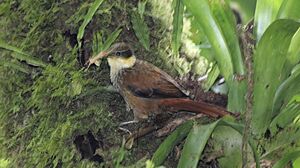Buffy tuftedcheek facts for kids
Quick facts for kids Buffy tuftedcheek |
|
|---|---|
 |
|
| Conservation status | |
| Scientific classification | |
| Genus: |
Pseudocolaptes
|
| Species: |
lawrencii
|
The buffy tuftedcheek (Pseudocolaptes lawrencii) is a cool bird that lives in the forests of Costa Rica and Panama. It's a type of passerine bird, which means it's a perching bird. It belongs to the ovenbird family called Furnariidae. This bird gets its name from the fluffy, pale golden feathers on its cheeks, which look like little tufts! It's also sometimes called Lawrence's tuftedcheek.
Contents
About Its Name
Scientists often group animals together based on how they are related. The buffy tuftedcheek used to be considered the same species as another bird, the streaked tuftedcheek. Later, it was thought to be a subspecies of the Pacific tuftedcheek.
However, in the mid-2010s, scientists decided that the buffy tuftedcheek and the Pacific tuftedcheek were different enough to be their own separate species. Major bird groups like the American Ornithological Society agreed with this change in 2022.
The bird's other name, Lawrence's tuftedcheek, honors an American bird expert named George Newbold Lawrence. The buffy tuftedcheek is a unique species, meaning it doesn't have any subspecies.
What It Looks Like
The buffy tuftedcheek is about 20 to 21 centimeters (8 inches) long. It weighs between 35 and 50 grams (1.2 to 1.8 ounces). Male and female birds look very similar. However, the female's beak is usually longer than the male's.
Feathers and Colors
The most special thing about this bird is its "tuft" of feathers. These are pale golden-brown feathers that stick out on the sides of its neck. It has a light, buff-white stripe above its eye. The feathers around its eyes and ears are dark brownish-black.
Its head is dark brownish-black with thin, light streaks. The back of its head has wider streaks. The rest of its back is reddish-brown with a faint dark pattern. Its rump, upper tail feathers, and tail are a bright reddish-orange. Its wings are dark brownish-black. They have light reddish and yellowish-brown tips on the coverts (small feathers). These tips form bars when the wing is closed.
Underneath and Beak
Its throat is whitish with a golden-brown tint. Its chest has a blurry pattern of wide dull brown and pale buff streaks. Its belly is a dull yellowish-brown with faint darker spots. Its sides are reddish-brown. The feathers under its tail are yellowish-brown to cinnamon-colored.
The bird's eyes are dark brown. Its upper beak is black to dark brown. The lower beak is usually lighter than the upper beak, but with a darker center. Its legs and feet are olive green to yellowish-olive.
Young Birds
Young buffy tuftedcheeks have a much shorter beak than adults. They don't have the streaks on their head. Their throat and chest have a dark brownish-black pattern. Their sides and belly are more reddish-brown.
Where It Lives
The buffy tuftedcheek lives in Costa Rica and Panama. You can find it in the central mountains of Costa Rica. Its range extends south into western Panama, reaching as far as Veraguas Province.
Its Home
This bird likes to live in humid mountain forests that stay green all year. It prefers areas that are a bit open. It also likes the edges of thicker forests and clearings with scattered trees. You can find it at high elevations. It lives from about 1,550 meters (5,085 feet) up to the timberline, which is around 3,000 meters (9,840 feet) high.
How It Behaves
Staying in One Place
The buffy tuftedcheek stays in the same area all year round. It does not migrate.
What It Eats
This bird mainly eats many different kinds of arthropods, like insects and spiders. It also sometimes eats small amphibians. It usually looks for food alone or in pairs. It often joins groups of different bird species that are foraging together.
It finds food by climbing along branches from the middle to the top of the forest. It mostly looks for prey in epiphytes, which are plants that grow on other plants. It especially likes to search in bromeliads. It also looks for food in moss and in piles of dead leaves.
How It Raises Its Young
Scientists believe that buffy tuftedcheeks stay with one mate for life. They build their nests between January and May in Costa Rica. They make their nests in holes in trees. These holes can be natural or made by small woodpeckers. The birds line the nest with plant materials, like fern scales.
Only one nest has been studied in detail. In that nest, one adult bird took care of a single egg and then a single baby bird. The baby bird stayed in the nest for at least 29 days.
Its Sounds
The buffy tuftedcheek sings mostly during the breeding season. Its song is a few short, clear notes followed by a bubbly, gurgling sound. It sounds like "peek...peek...prrreeee-e-e-e". It usually sings this phrase once, but sometimes repeats it several times.
It makes calls throughout the year, especially in the morning while looking for food. Its call is a loud, metallic, short sound like "peek!" or "spik!". The song is probably used to mark its territory. The call is thought to be for keeping in touch with its mate.
Its Status
The IUCN (International Union for Conservation of Nature) has assessed the buffy tuftedcheek. They have listed it as a species of "Least Concern." This means that it is not currently in danger of disappearing.
Even though it lives in a small area and its exact population size isn't known, scientists believe its numbers are stable. No immediate threats have been found for this bird. It is considered uncommon to fairly common in Costa Rica. It is rare in Panama. Luckily, it lives in several protected areas, which helps keep it safe.


